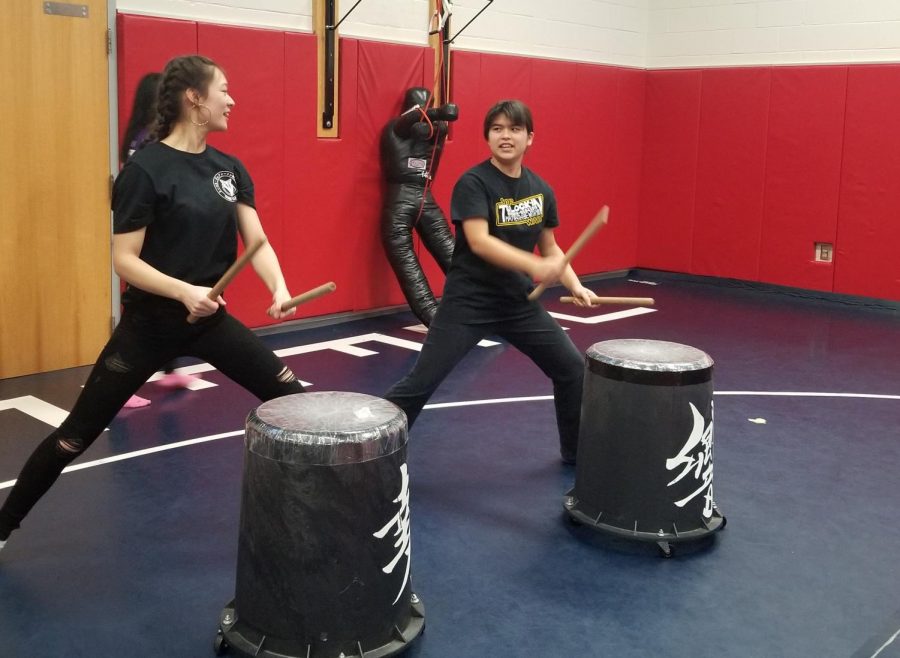Drumming your heart out
Sophomores Alyssa Rask (right) and Alana Nii (left) perform a taiko routine as a duet. “I love the program here at TJ because it’s very relaxed. I also do taiko outside of school, and my experience with the taiko community is just – there’s a lot of fantastic people,” Nii said.
December 19, 2019
Thunderous and steady, the heartbeat of the taiko drum rings out. Students stand beating out rhythms, bachi in hand and sweat dripping down their foreheads. A centuries old part of Japanese culture continues at Jefferson.
The word taiko directly translates to “fat drum” in the Japanese language. However, the term is generally used to refer to the art of Japanese drumming. Originally used by the military to intimidate enemies on the battlefield, taiko was later picked up by religions in Japan. After World War II, modern taiko developed, in which multiple taiko drums form an ensemble and play together. As Japanese immigrants came to America, they brought with them the tradition of this ancient instrument.
“Japanese taiko uses cow-hide on the head [of the drum]. Traditionally, we make taiko out of one piece of hollowed out log, but these days those big trees are not widely available so a lot of North American taiko uses [a mix of] different kinds of wood,” Japanese teacher Koji Otani said. “One of the most common ways to make taiko is to use wine barrels or whiskey barrels because some of those woods are very expensive. It costs minimum like eight to ten thousand [dollars] to make one [taiko drum], but a wine barrel taiko is probably five hundred dollars, including the skins and everything.”
Otani himself has had quite a bit of experience working with and making taiko. In fact, in the back of the Japanese classroom you will find stacks of practice taiko for students to use – all handmade by Otani.
“Typically with those practice taiko, [there are] two different types. [People either] use a large trash can, or people use a tire. For the skin, we use packing tape and make four or five layers,” Otani said. “My taiko doesn’t use one of those typical trash cans, [instead it uses] the basin of a sump pump. So, it’s a little different but it looks much better than the trash can. For the ease of mobility, I put caster wheels on a bar [on the bottom], so the whole thing probably cost fifty dollars.”
Students roll the practice taikos to the wrestling room every Friday for eighth period A block to practice and polish their skills. Sophomore Alana Nii started playing taiko in her freshman year and continues to join taiko practices this year.
“My aunt actually does taiko in California, and when I came here, sensei [Otani] was talking about taiko since he does it, and he really loves the activity, and it’s an iNite performance here at TJ, so I was like ‘Hey, this is a great opportunity to try something new!’ ” Nii said.
Taiko involves many technical aspects, such as hitting the drum in the right way and staying on beat, but it’s also important to add a little stylistic flair when performing.
“When we play taiko for a performance, we focus on, of course, the musical aspects, and also playing with style. So, we spend a lot of time [learning] how to move, how to stand, how to move [your] arms. In a way, we focus on, at the same time, musical aspects – [which is] one [part], and another aspect is to play with style. We want to play so that it will look good and cool on the stage,” Otani said.
For Nii, playing taiko is a way to de-stress and take a break from the rigor of day to day activities.
“I have so much fun with it [taiko]. I think it’s a great way to relieve stress, especially as an eighth period, [after you] take chem tests you can just drum your feelings out,” Nii said.
Taiko, beyond being a form of musical expression, is a very spiritual way for students to connect with Japanese culture.
“Taiko has a lot to do with spirituality. We don’t do this for eighth period normally, but when I go to taiko practice every week, we start with meditation for about one minute. So, I would say taiko is very spiritual and also you can learn a lot about cultural aspects of traditional Japanese culture,” Otani said. “Taiko is very simple, but can be very deep. So by playing simple music, they [students] can explore the deep world of Japanese culture.”






